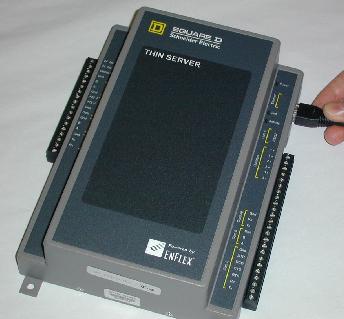Device Profile: Square D power management device
Nov 3, 2000 — by Rick Lehrbaum — from the LinuxDevices Archive — 1 viewsSquare D (LaVergne, TN) has embedded Linux inside a newly developed power system monitoring and control appliance. The device, called the POWERLOGIC Thin Server, contains a PC-like ('X86') embedded computer that makes use of Linux and other open source software as its internal operating system environment.
The new Internet-based power management device is intended to give companies the tools and information they require in order to deal with deregulation in the electrical power industry. In addition to the standard metering required of plant engineers, the system collects and delivers critical information to accounting, purchasing, and resource management systems. Since the system is intended for remote data acquisition and control applications, it does not have its own display. Instead, it provides an intuitive browser-based graphical user interface that allows remote users to collect, analyze, and respond to power management data.

The device, which measures 6.0 x 8.0 x 2.2 in., contains an embedded computer that is based on a 133MHz AMD 486 CPU. Square D chose that processor because it is 'X86' compatible and it provides a reasonable tradeoff between the performance and power consumption requirements of typical thin server/gateway applications. The standard memory configuration is 16MB, but 32MB and 64MB will be offered in the future.
A tiny internal CompactFlash card holds the Linux based operating system, webserver software, device drivers, and control programs, plus (normally) up to 20MB of local data storage. Larger capacity CompactFlash cards are offered as options, as is a large-capacity IBM Microdrive (a rotating-magnetic media hard disk in the CompactFlash form-factor).
Software details
The embedded Linux operating system is currently based on kernel 2.0.18 which, although “ancient” by desktop PC standards, has proven fully adequate for the Square D's POWERLOGIC Thin Server application. Square D opted to develop their own “ultra-slim” embedded webserver, in an effort to conserve precious disk and memory resources, rather than using an off-the-shelf embedded webservers. There are several mechanisms in place to assist with system updates and upgrades.
The system supports installation and upgrade of its OS and internal software other via network boot. This can be done from a running system or, in the case of systems without an OS image on the hard drive, it can be accomplished via a maintenance function that is contained within the unit's customized PC-like BIOS.
What it does
Basically, the device connects fieldbus-interfaced data acquisition and control devices, interfaced via a MODBUS compatible RS485 multi-drop interface, to a TCP/IP-based Ethernet LAN so that they may be monitored and controlled remotely. The system can serve as a simple “pass through” gateway, but its real utility is in providing programmable higher level services.
Typically, the system logs information from field devices, checks for out-of-spec conditions, initiates email or paging alarms when appropriate, serves up web pages so real-time data can remotely viewed, and pushes information to system-wide data warehouses according to predetermined schedules.
Why Linux?
“Reliability was a major issue in our decision to use embedded Linux, because electricity is a critical factor of production that cannot be taken for granted,” said Andy Foerster, Square D Product Marketing Manager.
The company originally contracted with Wirespeed (Huntsville, AL) to develop the Linux driver software that was required to interface to power monitoring and control instruments via the RS485-based MODBUS protocol. Subsequent to Red Hat's acquisition of Wirespeed, Red Hat continued supporting Square D's thin server project. “Teaming with Red Hat, the industry leader, delivered us the open source expertise necessary to deploy new technology rapidly and efficiently to our customers,” observed Foerster.
This article was originally published on LinuxDevices.com and has been donated to the open source community by QuinStreet Inc. Please visit LinuxToday.com for up-to-date news and articles about Linux and open source.